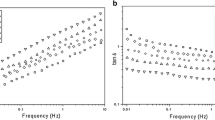Abstract
Silica sol was first used as an inorganic component to form poly(acrylamide) (PAM)/silica composite hydrogels via in situ free-radical polymerization. The gelation reaction of the composite materials was monitored on a rheometer, indicating that the gelling induction time becomes longer with the increasing content of silica sol. Compression strength and elastic modulus of the composite hydrogels were significantly improved by adding silica sol compared with pure PAM hydrogels. Silica particles formed by silica sol were dispersed on the surface of PAM polymer network in nanosize, promoting high degree of attachment to the polymer chain and enhancing the interfacial interaction between these two components. TGA analysis showed that the silica stiffens the hydrogel network by creating additional physical cross-linking point, but the breakable nature of the bonds and a broad distribution of distances between crosslinks may creates most likely a wide dissipative zone.





Similar content being viewed by others
References
Tanaka Y, Gong JP, Osada Y (2005) Novel hydrogels with excellent mechanical performance. Prog Polym Sci 30:1–9
Haraguchi K (2007) Nanocomposite hydrogels. Curr Opin Solid State Mater Sci 11:47–54
Johnson JA, Turro NJ, Koberstein JT, Mark JE (2010) Some hydrogels having novel molecular structures. Prog Polym Sci 35:332–337
An FQ, Feng XQ, Gao BJ (2009) Adsorption of aniline from aqueous solution using novel adsorbent PAM/SiO2. Chem Eng J 151:183–187
Shi XM, Xu SM, Lin JT, Shun F, Wang JD (2009) Synthesis of SiO2-polyacrylic acid hybrid hydrogel with high mechanical properties and salt tolerance using sodium silicate precursor through sol–gel process. Mater Lett 63:527–529
Labarre D, Laurent AL, Lautier A, Bouhni S (2002) Complement activation by substituted polyacrylamide hydrogels for embolisation and implantation. Biomaterials 23(11):2319–2327
Haraguchi K, Takada T (2010) Synthesis and characteristics of nanocomposite gels prepared by in situ photopolymerization in an aqueous system. Macromolecules 43:4294–4299
Zhou CJ, Wu QL, Yue YY, Zhang QG (2011) Application of rod-shaped cellulose nanocrystals in polyacrylamide hydrogels. J Colloid Interface Sci 353:116–123
Li J, Suo JP, Jia LT (2010) Morphologies and mechanical properties of organic–inorganic multilayered composites. Polym Eng Sci 50:689–696
Lin WC, Fan W, Marcellan A, Hourdet D, Creton C (2010) Large strain and fracture properties of poly(dimethylacrylamide)/silica hybrid hydrogels. Macromolecules 43:2554–2563
Heinrich G, Kluppel M (2002) Recent advances in the theory of filler networking in elastomers. Adv Polym Sci 160:1–44
Ghosh P, Dev D, Samanta AK (1995) Graft copolymerization of acrylamide on cotton cellulose in a limited aqueous system following pretreatment technique. J Appl Polym Sci 58(10):1727–1734
Liu Y, Zhu MF, Liu XL, Zhang W, Sun B, Chen YM, Adler H-JP (2006) High clay content nanocomposite hydrogels with surprising mechanical strength and interesting deswelling kinetics. Polymer 47:1–5
Winter HH, Chambon F (1986) Analysis of linear viscoelasticity of a crosslinking polymer at the gel point. J Rheol 30:367–382
Tang QW, Wu JH, Lin JM, Li QH, Fan SJ (2008) Two-step synthesis of poly acrylamide/polyacrylate interpenetrating network hydrogels and its swelling/deswelling properties. J Mater Sci 43:5884–5890
Vílcu R, Irinei F, Ionescu-Bujor J, Olteanu M, Demetrescu I (1985) Kinetic parameters obtained from TG and DTG cures of acrylamide-maleic anhydride copolymers. J Therm Anal 30:495–502
Bhardwaj P, Singh V, Mandal UK, Aggarwal S (2010) Polyacrylamide and poly(acrylamide-co-2-acrylamido-2-methyl-1-propanesulfonic acid)-silica composite nanogels through in situ microemulsion polymerisation. J Mater Sci 45:1008–1016
Acknowledgment
The financial support of this work by the National Natural Science Foundation of China (No. 50673080) is gratefully acknowledged.
Author information
Authors and Affiliations
Corresponding author
Rights and permissions
About this article
Cite this article
Wu, L., Zeng, L., Chen, H. et al. Effects of silica sol content on the properties of poly(acrylamide)/silica composite hydrogel. Polym. Bull. 68, 309–316 (2012). https://doi.org/10.1007/s00289-011-0536-6
Received:
Revised:
Accepted:
Published:
Issue Date:
DOI: https://doi.org/10.1007/s00289-011-0536-6




